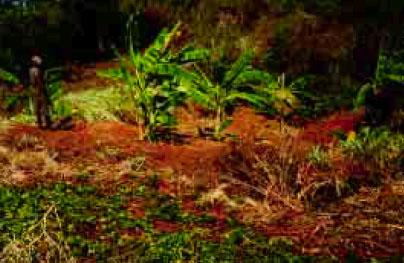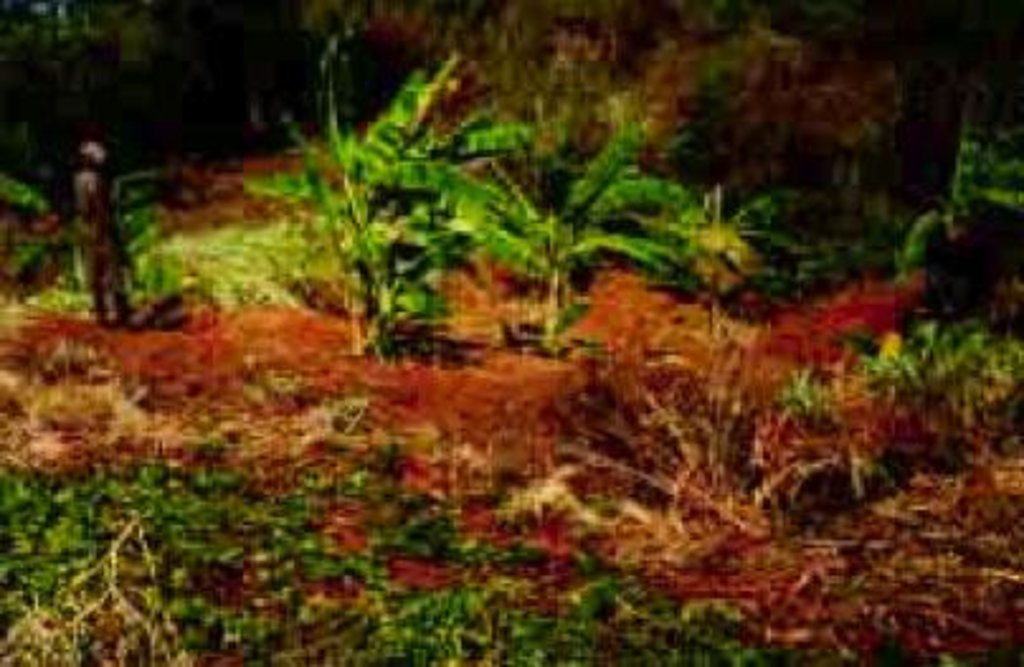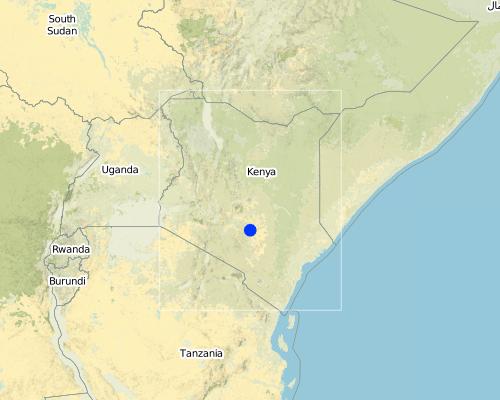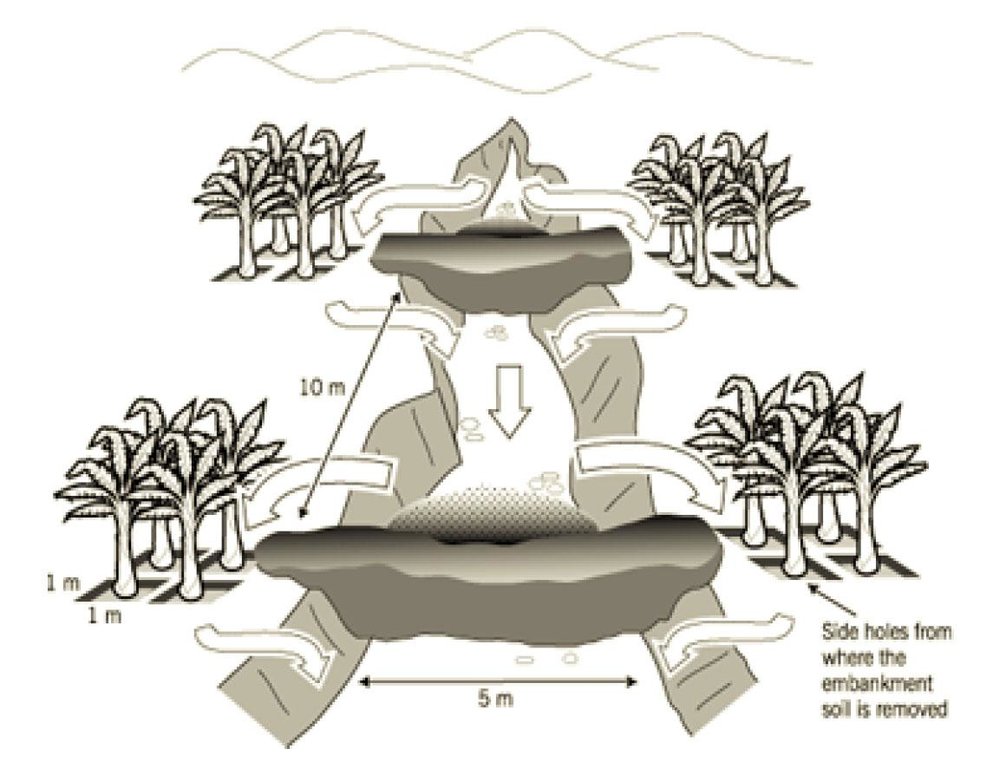Gully Rehabilitation [كينيا]
- تاريخ الإنشاء:
- تحديث:
- جامع المعلومات: Kithinji Mutunga
- المحرر: –
- المُراجع: David Streiff
technologies_1488 - كينيا
عرض الأقسام
توسيع الكل طي الكل1. معلومات عامة
1.2 تفاصيل الاتصال بالأشخاص الرئيسيين لمصدر المعلومات والمؤسسات المشاركة في تقييم وتوثيق التقنية
متخصص في الإدارة المستدامة للأراضي:
Kiio Jacqueline
MOARD
كينيا
مستخدم الأرض:
Kirimi Patrick
MOARD
كينيا
متخصص في الإدارة المستدامة للأراضي:
Gitau Mary
MOARD
كينيا
اسم المؤسسة (المؤسسات) التي سهلت توثيق/تقييم التقنية (إذا كان ذلك على صلة)
Food and Agriculture Organization of the United Nations (FAO) - إيطاليا1.3 الشروط المتعلقة باستخدام البيانات الموثقة من خلال WOCAT
متى تم تجميع البيانات (ميدانيا)؟:
26/04/2000
يوافق جامع المعلومات والشخص (لاشخاص) الرئيسي لمصدر المعلومات على الشروط المتعلقة باستخدام البيانات الموثقة من خلال WOCAT:
نعم
2. وصف تقنيةالإدارة المستدامي للأراضي
2.1 وصف مختصر للتقنية
تعريف التقنية:
Erosion control by use of physical barriers and vegetative materials
2.2 وصف تفصيلي للتقنية
الوصف:
The innovation comprises control of gully erosion by use of constructed barriers (check dams) combined with vegetative materials. The end result is a stabilized gully that is prevented from advancing further. The system also involves fruit trees/banana establishment and fodder grass planting for structure stabilization. Establishment of the technology involves excavation of pits, planting fruit trees/bananas and grass cuttings.
Purpose of the Technology: This is a structural measure that is vegetated for stabilization. Its purpose is to rehabilitate a gully bed, through control of concentrated runoff by reduction of slope length and both trapping of runoff and sediment harvesting. The productive use of the innovation is mainly for perennial crops (fruit trees and
bananas) and for fodder production.
Establishment / maintenance activities and inputs: Earth check dams are constructed in the gully, using borrow spoil from square pits in the walls of the gully (see diagram). The earth embankment of the dams are then stabilized with grass. Pawpaws are planted on the original gully floor. Initially the innovator left the pits empty: now she plants bananas in them.The 5 check dams, each 1 m or more in height, are spaced at about 10 m apart in the gully. The excavated pits are about 1 m x 1 m wide and 1 m deep. Four pits are dug separately on each side of each check dam. Makarikari grass (Panicum coloratum var. makarikariensis) is used for stabilization, while bananas and pawpaws are planted within the rehabilitated area. When it rains, runoff generated from the neighbouring plots upstream flows down and is slowed by the check dams. The runoff passes around both wings of each embankment, filling and flowing through the pits. Sediment is trapped in the pits. Excess runoff flows on to the second embankment, then through the
second set of pits and so on. Only during heavy rains does water pass through and out of the system, though its velocity is reduced. Thus the gully heals slowly with time and vegetation becomes established. Regular maintenance work is required, involving repair of broken sections from time to time, using
manual labour with a panga, shovel and jembe. Also of importance is manure application every season to the planted areas before the rains to sustain fertility and thus productivity.
Natural / human environment: Kalekye Mutua is a single household head in her mid thirties. Although she has no partner to help support her three children, she manages quite well through farming her 6 hectares of land - where she grows various crops and keeps a few local cattle. She had a small trading venture but has recently abandoned
this. Kalekye is not amongst the poorest in Mwingi, but represents a number of female-headed households who prosper through hard work and enterprise. In fact she even employs labourers part-time to help with the farming activities.
2.3 صور التقنية
2.5 البلد/المنطقة/المواقع التي تم تنفيذ التقنية فيها والتي يغطيها هذا التقييم
البلد:
كينيا
المنطقة/الولاية/المحافظة:
Eastern Province
Map
×2.6 تاريخ التنفيذ
في حالة عدم معرفة السنة بالتحديد، يرجى الإشارة إلى التاريخ التقريبي:
- منذ أكثر من 50 عامًا (تقليدي)
2.7 إدخال التقنية
حدد كيف تم إدخال التقنية:
- كجزء من النظام التقليدي (> 50 عامًا)
التعليقات (نوع المشروع، الخ):
farmers own intiative
3. تصنيف تقنية الإدارة المستدامي للأراضي
3.1 الغرض الرئيسي ( الأغراض الرئيسية) للتقنية
- الحد من تدهور الأراضي ومنعه وعكسه
3.2 نوع (أنواع) استخدام الأراضي الحالية حيث يتم تطبيق التقنية

الأراضي الزراعية
- زراعة معمرة (غير خشبية)
التعليقات:
Major land use problems (compiler’s opinion): soil erosion, overgrazing, declining soil fertility
Major land use problems (land users’ perception): low yields
3.3 مزيد من المعلومات حول استخدام الأراضي
إمدادات المياه للأرض التي يتم تنفيذ التقنية عليها:
- بعلية
عدد مواسم الزراعة في السنة:
- 2
حدد:
Longest growing period in days: 60 Longest growing period from month to month: Oct - Dec Second longest growing period in days: 75 Second longest growing period from month to month: Mar - May
3.4 مجموعةالإدارة المستدامة للأراضي التي تنتمي إليها هذه التقنية
- تحسين الغطاء الأرضي/النباتي
- حصاد المياه
- تحويل المياه والصرف
3.5 انتشار التقنية
حدد انتشار التقنية:
- منتشرة بالتساوي على مساحة
إذا كانت التقنية منتشرة بالتساوي على منطقة ما، فحدد المنطقة التقريبية المغطاة:
- < 0.1 كم2 (10 هكتار)
التعليقات:
a very small portion of the individual farm is covered by the technology
3.6 التدابير التقنية في مجال إلادارة المستدامة للأراضي

التدابير النباتية

التدابير البنيوية
- S3: الخنادق المتدرجة ،والقنوات، والممرات المائية
التعليقات:
Main measures: vegetative measures
Secondary measures: structural measures
3.7 الأنواع الرئيسية من تدهور الأراضي التي تناولتها التقنية

تآكل التربة بالمياه
- (Wg):الانجراف الخلجاني/ الخلجان
3.8 منع أو حد أو عكس تدهور الأراضي
تحديد هدف التقنية فيما يتعلق بتدهور الأراضي:
- الحد من تدهور الأراضي
4. المواصفات الفنية، وأنشطة التنفيذ، والمدخلات، والتكاليف
4.1 الرسم الفني للتقنية
4.2 المواصفات الفنية/شروحات الرسم الفني
Gully under reclamation: note flow of runoff
Kenya
Technical knowledge required for field staff / advisors: low
Technical knowledge required for land users: moderate
Main technical functions: control of concentrated runoff: retain / trap, control of concentrated runoff: impede / retard
Secondary technical functions: reduction of slope angle, improvement of ground cover, increase of infiltration, water harvesting / increase water supply, sediment retention / trapping, sediment harvesting
Fruit trees / shrubs species: pawpaws
Perennial crops species: bananas
Slope (which determines the spacing indicated above): 10.00%
If the original slope has changed as a result of the Technology, the slope today is (see figure below): 5.00%
Construction material (earth): Local soil excavated from pits on the side of the gully
Construction material (other): Grass for stabilization Makarikari grass prefeered
Slope (which determines the spacing indicated above): 10%
If the original slope has changed as a result of the Technology, the slope today is: 8%
Vegetation is used for stabilisation of structures.
4.3 معلومات عامة بخصوص حساب المدخلات والتكاليف
عملة أخرى/ عملة وطنية (حدد):
kenya shillings
أشر إلى سعر الصرف من الدولار الأمريكي إلى العملة المحلية (إذا كان ذا صلة): 1 دولار أمريكي =:
70,0
اذكر متوسط تكلفة أجر العمالة المستأجرة في اليوم الواحد:
2.14
4.4 أنشطة التأسيس
| النشاط | نوع التدبير | التوقيت | |
|---|---|---|---|
| 1. | digging banana holes | نباتية | dry season |
| 2. | acquisition of grass cuttings | نباتية | dry season |
| 3. | acquisition of banana cuttings | نباتية | before |
| 4. | planting of grass and bananas | نباتية | onset of rain |
| 5. | manure application | نباتية | before the rains |
| 6. | Excavation | بنيوية أو هيكلية | Dry season |
4.5 التكاليف والمدخلات اللازمة للتأسيس
التعليقات:
Duration of establishment phase: 24 month(s)
4.6 الصيانة/الأنشطة المتكررة
| النشاط | نوع التدبير | التوقيت/الوتيرة | |
|---|---|---|---|
| 1. | repair of broken structures | نباتية | after rains /seasonally |
| 2. | weeding | نباتية | during rains /twice /season |
| 3. | banana prunning | نباتية | after rains /biannually |
| 4. | manure application | نباتية | dry season /annually |
| 5. | Repair of broken sections | بنيوية أو هيكلية | during /after rains/seasonally |
| 6. | Stabilization with grass | بنيوية أو هيكلية | during rains/when required |
4.7 التكاليف والمدخلات اللازمة للصيانة/للأنشطة المتكررة (سنويًا)
التعليقات:
1100 banana/ fruit trees holes/ha
4.8 أهم العوامل المؤثرة على التكاليف
قدم وصفا لأهم العوامل التي تؤثر على التكاليف:
slope, soil type, timeliness of operation
5. البيئة الطبيعية والبشرية
5.1 المناخ
هطول الأمطار السنوي
- < 250 مم
- 251- 500 ملم
- 501 - 750ملم
- 1,000-751 ملم
- 1,500-1,100 ملم
- 2,000-1,500 ملم
- 3,000-2,001 ملم
- 4,000-3,100 ملم
- > 4000 ملم
المنطقة المناخية الزراعية
- شبه قاحلة
5.2 طوبوغرافيا
متوسط الانحدارات:
- مسطح (0-2%)
- بسيط (3-5%)
- معتدل (6-10%)
- متدحرج (11-15%)
- تلال (16-30%)
- شديدة الانحدار(31-60%)
- فائقة الانحدار (>60%)
التضاريس:
- هضاب/سهول
- أثلام مرتفعة
- المنحدرات الجبلية
- منحدرات التلال
- منحدرات في السفوح
- قاع الوادي
المنطقة الارتفاعية:
- 100-0 متر فوق سطح البحر
- 500-101 متر فوق سطح البحر
- 1,000-501 متر فوق سطح البحر
- 1,500-1,001 متر فوق سطح البحر
- 2,000-1,501 متر فوق سطح البحر
- 2,500-2,100 متر فوق سطح البحر
- 3,000-2,501 متر فوق سطح البحر
- 4,000-3,001 متر فوق سطح البحر
- > 4000 متر فوق سطح البحر
5.3 التربة
متوسط عمق التربة:
- ضحل جدًا (0-20 سم)
- ضحلة (21-50 سم)
- متوسطة العمق (51-80 سم)
- عميقة (81-120 سم)
- عميقة جدًا (> 120 سم)
قوام التربة (التربة السطحية):
- خشن / خفيف (رملي)
المواد العضوية في التربة السطحية:
- منخفضة (<1%)
إذا كان متاحًا، قم بإرفاق وصف كامل للتربة أو تحديد المعلومات المتوفرة، على سبيل المثال نوع التربة، الرقم الهيدروجيني/ درجة حموضة التربة، قدرة التبادل الكاتيوني، النيتروجين، الملوحة وما إلى ذلك.
Soil fertility is low
Soil drainage / infiltration is good
Soil water storage capacity is low
5.6 خصائص مستخدمي الأراضي الذين يطبقون التقنية
الدخل من خارج المزرعة:
- أقل من % 10من كامل الدخل
مستوى المكننة:
- عمل يدوي
اذكر الخصائص الأخرى ذات الصلة لمستخدمي الأراضي:
Population density: < 10 persons/km2
Annual population growth: 2% - 3%
1% of the land users are very rich and own 10% of the land.
4% of the land users are rich and own 20% of the land.
25% of the land users are average wealthy and own 40% of the land.
30% of the land users are poor and own 20% of the land.
40% of the land users are poor and own 10% of the land.
Off-farm income specification: the are few members of the household who are in formal employment
5.8 ملكية الأراضي، وحقوق استخدام الأراضي، وحقوق استخدام المياه
ملكية الارض:
- فردية، لا يوجد سند ملكية
حقوق استخدام الأراضي:
- فردي
6. الآثار والتصريحات الختامية
6.1 الآثار التي أظهرتها التقنية في الموقع
الآثار الاجتماعية والاقتصادية
الإنتاج
إنتاج الأعلاف
منطقة الإنتاج
الدخل والتكاليف
دخل المزرعة
التعليقات/ حدد:
Sale of bananas
الآثار الايكولوجية
دورة المياه / الجريان السطحي
الجريان السطحي
الكمية قبل الإدارة المستدامة للأراضي:
60
الكمية بعد الإدارة المستدامة للأراضي:
10
التربة
رطوبة التربة
غطاء التربة
فقدان التربة
الكمية قبل الإدارة المستدامة للأراضي:
610
الكمية بعد الإدارة المستدامة للأراضي:
1
6.4 تحليل التكلفة والعائد
كيف يمكن مقارنة العوائد نسبة لتكاليف الإنشاء (من وجهة نظر مستخدمي الأراضي)؟
عوائد قصيرة الأجل:
إيجابي قليلا
عوائد طويلة الأجل:
ايجابي جدا
كيف تتم مقارنة العوائدمع كلفة الصيانة/التكاليف المتكررة (من وجهة نظر مستخدمي الأراضي)؟
عوائد قصيرة الأجل:
إيجابي
عوائد طويلة الأجل:
إيجابي
6.5 اعتماد التقنية
- حالات فردية/تجريبية
إذا كان متاحًا، قم بتحديد الكمية (عدد الأسر المعيشية و/أو المساحةالمغطاة):
1 household
من بين جميع الذين تبنوا التقنية، كم عدد الذين فعلوا ذلك بشكل تلقائي، أي دون تلقي أي حوافز مادية/مدفوعات؟:
- 100-90%
التعليقات:
100% of land user families have adopted the Technology without any external material support
There is no trend towards spontaneous adoption of the Technology
Comments on adoption trend: Kalekye only started the innovation two years ago, and while there has been a policy of taking women’s groups to visit Kalekye, this is a relatively recent occurrence (starting approximately a year ago). Despite the visitors obviously being inspired, there have been no reports as yet of direct adoption of the technology.
6.7 نقاط القوة / المزايا / الفرص التي توفرها التقنية
| نقاط القوة/ المزايا/ الفرص من وجهة نظر جامع المعلومات أو غيره من الاشخاص الرئيسيين لمصدر المعلومات |
|---|
|
Reclamation of land for production of fodder and bananas How can they be sustained / enhanced? Possible improvements would include planting improved fruit trees that are rapidly maturing and yield more: grafted mangoes for example |
6.8 نقاط ضعف / مساوىء / مخاطر التقنية وسبل التغلب عليها
| نقاط الضعف/ المساوىء/ المخاطر من وجهة نظر جامع المعلومات أو غيره من الاشخاص الرئيسيين لمصدر المعلومات | كيف يمكن التغلب عليها؟ |
|---|---|
| High labour requirements |
7. المراجع والروابط
7.2 المراجع للمنشورات المتاحة
العنوان، المؤلف، السنة، النظام القياسي الدولي لترقيم الكتب ISBN:
Farm Management handbook of Kenya Vol II
متاح من أين؟كم التكلفة؟:
Ministry of Agiculture, Nairobi
العنوان، المؤلف، السنة، النظام القياسي الدولي لترقيم الكتب ISBN:
Kithinji M., Critchley W. 2001. Farmers' initiatives in land husbandry: Promising technologies for the drier areas of East Africa. RELMA Technical Report series no. 27
الروابط والوحدات المواضيعية
توسيع الكل طي الكلالروابط
لا يوجد روابط
الوحدات المواضيعية
لا يوجد وحدات مواضيعية





